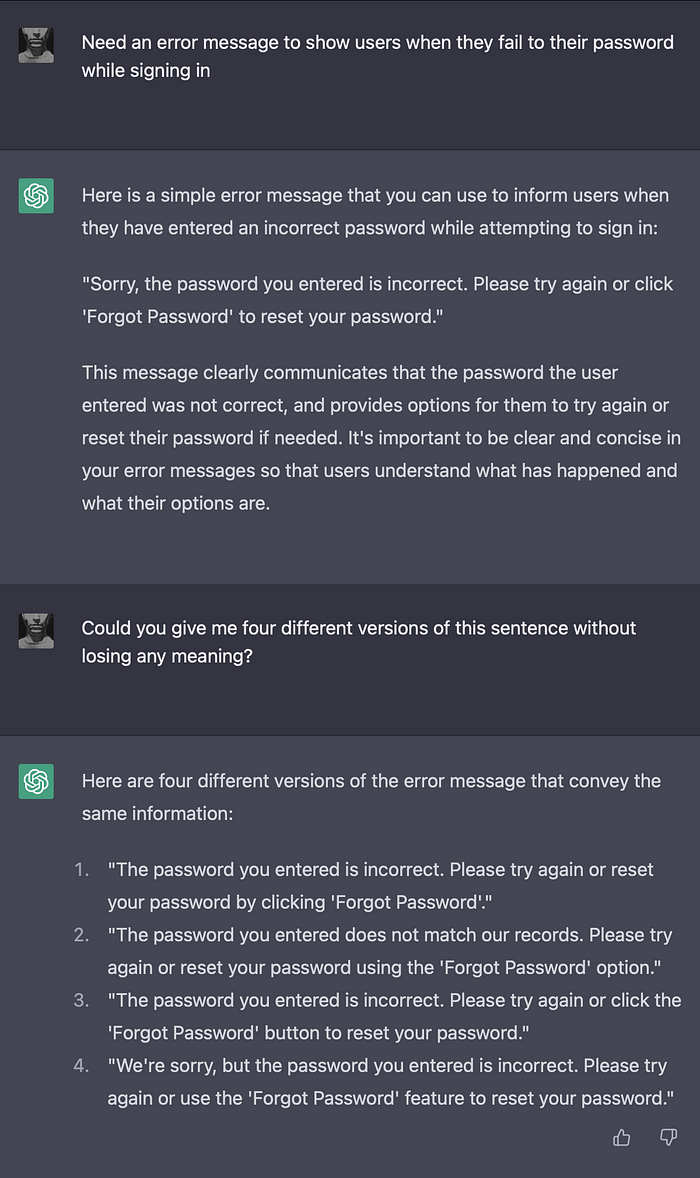How good are ChatGPT’s UX writing skills?
A test and analysis of ChatGPT’s UX Writing skills, its responses, and a demonstration of how it should be conducted.

AI power surrounds us day to day; meanwhile, tech professionals are rightly trying to utilize it to facilitate their work process. So it is pretty fair to entitle them; that’s how human beings have come today.
As a UX Designer, defining the words and sentences in UX Writing phase could be stressful throughout the design process because of the interferences from stakeholders. Unfortunately, you might be unable to avoid that and not find a way out of the mess.
To understand and execute UX Writing better, I’d got a book that named “Writing is Designing: Words and the User Experience” written by Andy Welfle -Content Design Manager at Adobe-, and Michael J. Metts -Principal Content Designer at Expedia Group-, published by Rosenfeld Media.
And meanwhile, an AI-Powered chatbot named ChatGPT by OpenAI has been coming up with a sensation.
“Writing is Designing: Words and The User Experience”

The book briefly mentions how you can establish a UX maturity in the company, where to start, how to execute the processes and influence stakeholders, and explain the fundamentals of the UX Writing methodology to implement from brand guidelines to product interface.
I’d like to personally appreciate the authors’ efforts in the book they’ve brought to the UX literature.
“This But Not That” method
The book mentions one of the UX Writing methods “This But Not That”, initially written in “Nicely Said” by Nicole Fenton and Kate Kiefer-Lee, to implement and maintain consistency in the language of the product. The method defines the tone of the language with adjectives with comparison, for example:
- Simple but not shallow
- Sincere but not slack
- Smart but not know-it-all, etc.
Using adjectives to produce comes you a bit familiar? This is how AI works and how we conduct it. I’ve intertwined these two concepts for UX Writing. Let’s get started:
UX Writing with ChatGPT
To understand ChatGPT’s UX Writing skills, I divided UX Writing concepts into three clusters. That would have helped me understand ChatGPT’s responses according to the requirements, difficulty levels, and restrictive and iterative inputs. To acquire that, I defined the requirements I’ll ask for and then allocated the difficulty levels as follows:
- Fundamental UX Writing (Easy)
- Contextual UX Writing (Moderate)
- Persuasive UX Writing (Expert)
1. Fundamental UX Writing (Easy)
The most straightforward resolutions are generally hard to find; you cannot see the nuances between options. It can be complicated to ask someone else who is not more sophisticated than you as well. I examined ChatGPT whether it can be that person:

Test 1.1: Rate our app
For the first test, I went easy and asked it to give me two basic CTA wordings with 12 characters limit:

Test 1.2: Wrong password
I asked it to get a basic error message of the wrong password and asked it to alternate four different sentences without losing any meaning:

Test 1.3: Dismiss & Remove & Delete?
These wordings are the kings of the conflicts of UX Writing; generally, no one can distinguish their meanings. So I examined its skill of discrimination of the actions’ meaning, and it responded well:

2. Contextual UX Writing (Moderate)
Writing fundamental content may seem easy. I examined it to be sure that we UX Designers / Writers could use it in any case without hesitation and strain it harder. I hypothetically contrived a Q-Commerce start-up and a requirement plan. I defined some restrictive inputs from easy to hard and from reasonable to unreasonable to examine it if it fails:

Restrictive inputs:
- Simple but not shallow
- Sincere but not slack
- Smart but not know-it-all
- Short sentences
- Have a headline with max. 48 characters
- Paragraph can be max. 256 characters in a single sentence
- Use contractions
- Generate four examples
- Mustn’t apologize
- Call the user “his nibs”
Test 2.1: Campaign notification
In this example, I examined whether it understands the contextual parameters, and asked it to create a short sentence:

Test 2.2: No product left
I geared up the difficulty level and asked it a bit complex case by using the “This but not That Method” with four examples:

Test 2.3: Return the product
Here we have a scenario and user flow. I examined it to see if it understands the scenario, reasons, and connections of the parameters and if it creates a meaningful headline and sentence with character limitation and with some unreasonable inputs:

3. Persuasive UX Writing (Expert)
UX Writing is more than the wording, sometimes you need to conduct users' attention and behaviors according to the business requirements. It can be hard to decide and may need A/B testing regarding the case. I would like to examine the ChatGPT whether it can decide or suggest any reasonable ideas. If it makes it, it could be groundbreaking:

Test 3.1: Delete account
I asked it to generate a dissuasive CTA to avoid losing users from deleting their accounts:

Test 3.2: Subscribe newsletter
I asked it how to increase the subscription rate of a newly published newsletter with the button’s wording:

Test 3.3: Allow app tracking
This is one of the most problematic UX cases, and you have to ask users for an allowance to track their activity and logs. To improve the company’s services, you need to hook them to gather their data to provide them with a better experience. I asked it to provide me persuasive headline, paragraph, and two buttons CTAs, and the results were incredible:

Evaluation of ChatGPT’s UX Writing skills — Pros & Cons
The examples above are the results that include proper answers. I have yet to put the mistaken results here. I tried many times, but sometimes ChatGPT needed help understanding and responding for valid results. But we can ignore that; the failure rate is almost as same as human beings. Overall, it gave proper and accurate responses, can be used for UX Writing, and makes the process easier. Pros and cons can be listed as follows:

Pros
- Provides proper and accurate responses
- Follows restrictive inputs
- Responds with alternatives
- Can be conducted iteratively
- Advises better responses than requested
- Advises UX Writing / Design ethics and maturity tips
- Time and effort saver
- Can be used by UX / Product / Marketing teams
Cons
- Have to know what your requirement and restrictions definitely are
- Have to learn how to use ChatGPT and how it reacts to your directions
- May provide irrelevant results by misdirection
- May respond wrong even if inputs are right
- Inclined to respond monotonously
- Similar results may be found in another product
- Data confidentiality might cause a problem with your company
Designer’s note
If you consider using ChatGPT for your UX Writing and Content Design works, you should really know your needs and requirements to conduct it well beforehand. You must conduct ChatGPT with exact and definite (really definite) wordings to get the response that you need. Otherwise, you might lose time and effort when you are trying to save.
You may rightly ask, “if I need to know everything before I ask, why would I use it?”. Of course, ChatGPT is not an ultimate UX Writer to use for work, but we can use it as a consultant.
This is not the end, this is the beginning of us
Since AI-powered tools have occurred, designers, writers, creators, and artists have been concerned. Their concerns are proper to have, like the hansom cab manufacturers’ during the industrial revolution, but we cannot deny how cars changed our lives.
Instead of concern, we should follow, participate and contribute to current technologies to improve the world.

